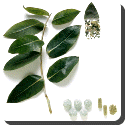 Eucalyptus — Eucalyptus is a diverse genus of trees (and a few shrubs), the members of which dominate the tree flora of Australia. There are more than seven hundred species of Eucalyptus, mostly native to Australia, with a very small number found in adjacent parts of New Guinea and Indonesia and one as far north as the Philippines islands. Many Eucalyptus have been planted in various parts of the world including the dry regions of Southern California and in Africa, Spain, South America, and on forestry plantations in India and China.
Eucalyptus — Eucalyptus is a diverse genus of trees (and a few shrubs), the members of which dominate the tree flora of Australia. There are more than seven hundred species of Eucalyptus, mostly native to Australia, with a very small number found in adjacent parts of New Guinea and Indonesia and one as far north as the Philippines islands. Many Eucalyptus have been planted in various parts of the world including the dry regions of Southern California and in Africa, Spain, South America, and on forestry plantations in India and China.
Members of the genus can be found in almost every region of the Australian continent, because they have adapted to all of its climatic conditions; in fact no other continent is so characterised by a single genus of tree as Australia is by its eucalyptus. Many, but far from all, are known as gum trees in reference to the habit of many species to exude copious sap from any break in the bark (e.g. Scribbly Gum).
A Eucalyptus may be mature as a low shrub or as a very large tree. There are three main habit and four size categories that species can be divided into.
As a generalisation “forest trees” are single-stemmed and have a crown forming a minor proportion of the whole tree height. “Woodland trees” are single-stemmed although they may branch at a short distance above ground level.
“Mallees” are multi-stemmed from ground level, usually less than 10 metres in height, often with the crown predominantly at the ends of the branchlets and individual plants may combine to form either an open or closed formation. Many mallee trees may be so low growing as to be considered a shrub.
Apart from the forest tree, woodland tree, mallee and shrub habits two further tree forms are notable in Western Australia. One of these is the “mallet”, which is a small to medium-sized tree, usually of steep branching habit, sometimes fluted at the base of the trunk and often with a conspicuously dense, terminal crown. It is the habit usually of mature healthy specimens of Eucalyptus occidentalis, E. astringens, E. spathulata, E. gardneri, E. dielsii, E. forrestiana, E. salubris, E. clivicola and E. ornata. The smooth bark of mallets often has a satiny sheen and may be white, cream, grey, green or copper.
Another habit category used in Western Australia is the “marlock”. This has been variously applied but Brooker & Hopper (2001) defined the term and restricted the use to describe the more or less pure stands of short, erect, thin-stemmed “trees” that do not produce lignotubers. These are easily seen and recognised in stands of E. platypus, E. vesiculosa and the unrelated E. stoatei. The marlock is distinguished from mallets which are taller and have a characteristic steep branching habit. The origin and use of the term “morrel” is somewhat obscure and appears to apply to trees of the western Australian wheatbelt and goldfields which have a long, straight trunk, completely rough barked. It is now used mainly for E. longicornis (Red Morell) and E. melanoxylon (Black Morrel).
 Kids Portal For Parents India Kids Network
Kids Portal For Parents India Kids Network






